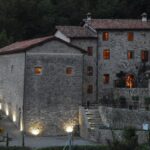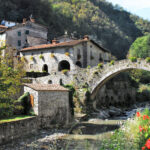Description
Fabbriche di Vallico rises in the Garfagnana territory, near the Turrite Cava stream at 349 m above sea level.
The history of the village of Fabbriche di Vallico, began with the foundation of a small hermitage, belonging to the order of St. Augustine dedicated to St. George and St. Galgano, which took place in 1214 in the locality of Valbona, thanks to some donations made by the people of the castle of Trassilico.
In a few years the small convent managed to have good revenues. It was not until 1461 when Innocent X through a "Papal Bull" ordered the suppression of all convents having less than ten religious that the convent was thus suppressed and united definitively with the Lucchese convent of St. Augustine.
At the beginning of the 14th century, with the arrival in the area of some blacksmiths from Bergamo, a short distance from the convent along the banks of the Turrite Cava stream, small workshops devoted to ironworking, and more specifically to the manufacture of nails, tools and much other material, began to spring up. The village found itself at the center of a bitter dispute that ended in the 15th century with the conquest of Fabbriche di Vallico by the Duchy of Modena, ruled by the Este family. From the second half of the 15th century, the House of Este assumed control of the entire Garfagnana area, and Fabbriche di Vallico was therefore annexed to the Duchy of Modena, sharing its fate and history until the Unification of Italy in 1861 by King Victor Emmanuel II of Savoy.
From the ironworking activity will also derive the name of the place "Fabbriche" which until the 19th century will represent a significant source of income for the population of that narrow and impervious valley, inhabited by man since the 4th-5th centuries BC.
In the village stands the ancient Church of St. Hyacinth the Apostle, dating back to the 13th century, where a convent previously stood, and inside we find a reproduction of the "Grotto of Lourdes."
In the village there are numerous testimonies of the medieval period such as the ancient bridge that joins the two banks of the stream, since the village stood on what were the borders between the Duchy of Modena and the Republic of Lucca a customs station was built there.
The hamlet also has several 15th-century palaces with charming loggias and gardens.
From the village of Fabbriche di Vallico it is possible to reach mountainous areas and attractions related to the beauty of the Apuan Alps that this area offers.




